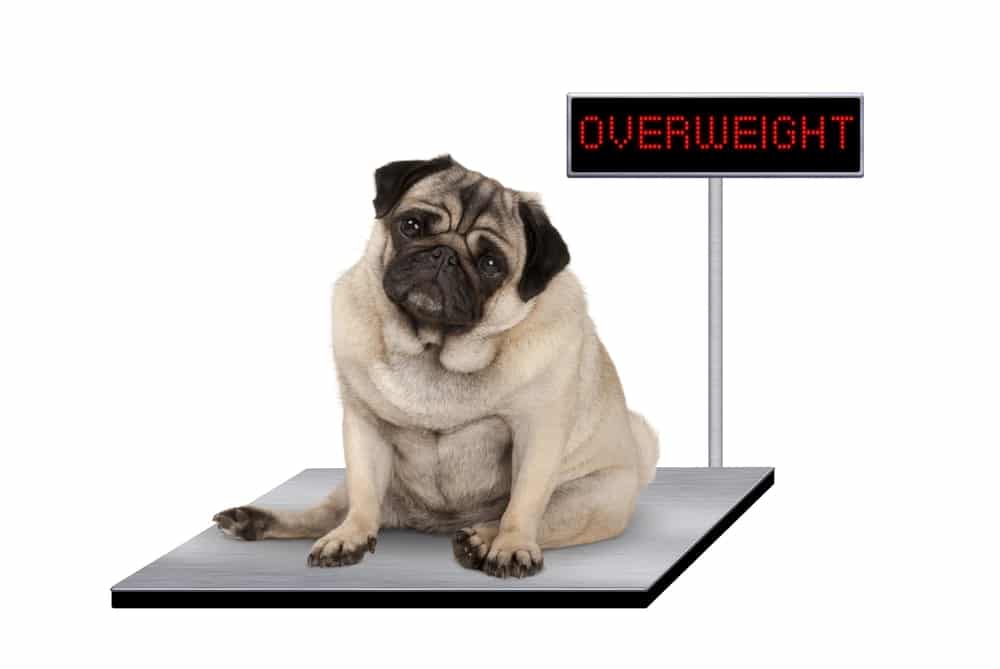Summary
To tell if your dog is overweight, check their body shape from above; a healthy dog has an hourglass figure, not oval. You should be able to easily feel their ribs without pressing hard. A sagging abdomen viewed from the side also indicates excess weight. Behavioral changes like lethargy and disinterest in exercise are further signs. Weigh your dog and compare it to the ideal weight for their breed (consult your vet). Obesity increases the risk of serious health issues. Help your dog lose weight through a vet-approved diet plan, regular exercise, and consistent monitoring.
Reasons for Dogs Becoming Overweight
Many reasons make your dog gain weight, ranging from genetic factors to lifestyle. Some of the reasons are:
Overfeeding and Diet
Most obese dogs are either overfed or are not following a healthy diet plan. You may think your dog will look cute if you make them feed more.
But that is not right. It would help if you did not overfeed the dog. Treats are okay but shouldn’t be shown in large quantities.
Age
Dogs between the ages of 6 to10 have a high risk of obesity.
Mood
Mood disorders like depression can make your dog obese.
Less Active
If your dog is less active, it can result in being overweight. Exercise is essential for keeping your dog healthy.
How to Tell if Your Dog is Overweight?
There are ways to determine obesity in your dogs other than going to a vet.
Dog’s Body Shape
Checking your dog’s body shape is the easiest way. Look at your dog from above. If your dog’s condition is oval, then your dog is fat. A healthy dog will have an hourglass-shaped body. The abdomen will be slimmer than the chest and hips.
Check Your Dog’s Ribs
Your dog is healthy if you can feel the ribs without pressing hard on them. If your dog is fat, then its ribs won’t be prominent.
Prominent Abdomen
A sagging abdomen is a sign of being overweight. If the chest is broader and the abdomen thinner when you look at your dog from the side, your dog is fit.
Less Interest in Physical Activities
If you notice changes in your dog’s activeness, it might indicate getting fat. If your active dog is not showing any interest in exercises or any activities, then your dog is not fit.
Change in Your Dog’s Behavior
Excessive sleeping, trouble walking, and heavy breathing after any activity are some signs indicating fat gain. Other behavioral changes are struggling to get up after lying and constant panting.
Check the Weight of Your Dog
Checking your dog’s weight can help determine if your dog is overweight. The healthy weight of dogs varies across different breeds. With the help of your vet, you can know the ideal weight of each breed. After this, you can check your dog’s weight and decide whether it is fat.
Dog Breeds Prone to Weight Gain
Some breeds are prone to obesity. They are:
- Labrador Retrievers
- Shelties
- Dachshunds
- Golden Retrievers
- Pugs
- Cocker Spaniels
- Pekingese
- Pomeranians
- Boxers
- Cairn Terriers
- Scottish Terriers
- Basset Hounds
- Cavalier King Charles Spaniels
- Beagles
- Mixed breeds
Medical Conditions Causing Overweight
Some dogs gain weight due to certain medical conditions like:
- Hypothyroidism – in middle-aged dogs, hypothyroidism in dogs can cause lowered metabolism.
- Cushing’s syndrome – in this condition, excess cortisol is produced. This leads to increased appetite and fat stores. Eventually, dogs gain extra weight.
- Osteoarthritis – this condition makes the dog less active, which leads to obesity.
Consequences of Overweight
Obesity in dogs can be highly dangerous and may lead to consequences like:
- Difficulty in breathing
- Risk for heat stroke
- Pancreatitis
- Diabetes
- Orthopaedic concerns
- Weak immune system
- Reduction in lifespan
- Mammary tumours
- Heart problems
- High blood pressure
How to Help Your Dog Lose Weight?
Now that you understand your dog is overweight, you should help it lose weight so that it will lead a healthy life.
You can help them lose weight with suggestions from your vet and a proper diet.
Consult Your Vet
This is the first step you can take. Your veterinarian can check your dog’s health status and suggest overcoming obesity. Set realistic goals for weight loss.
Regular Exercise
Being less active can be a significant factor contributing to weight gain. So, to make your pup healthy, make it do exercises regularly. It can be walks, small practices, or outdoor games. Engaging in activities can burn calories and help reduce weight.
Regular Check-Ups
Annual or twice-yearly checkups will be beneficial for keeping your dogs healthy. Regular check-ups will help examine early signs of illness and help monitor your dog’s weight.
Follow-up visits are necessary if your vet has given your dog a weight loss plan.
Diet Plan for Your Dog to Lose Weight
Your vet can suggest an ideal diet plan for your dog to lose weight. The steps of a weight loss plan are:
- As a primary step, the veterinarian will find your dog’s ideal body weight. It varies across breeds, so asking the vet to know the perfect weight is better. The importance may suggest how many calories your dog should eat daily.
- Cutting their daily extra calorie intake, as per the vet’s suggestion, aids in weight loss.
- Reduce giving carbs and fatty foods to your dog.
- Treats play an essential role in your dog’s daily calorie intake. As per the daily calorie limit the vet prescribes, you should plan how many treats you should give your dogs.
- Choose treats with just a few calories so that only a few calories are provided daily. You can also change the reward from giving a food item to a toy. Through this, they will be rewarded, and there won’t be any extra calories. It would help if you let others, especially children, know about the dog’s diet plan so they won’t be given anything not on your diet plan.
- Overfeeding is the main issue of most obese dogs. So, you should set a schedule for feeding your dog. Ideally, you can provide your dog with at least two meals daily. More than this can be done only after considering your dog’s diet chart.
- Check the weight once every two weeks. If you follow a proper diet plan, your dog will lose around two percent of its weight per week, or it can yield about eight percent of its weight per month.
- You can adjust calories as per the dog’s weight loss. Calorie intake can be increased or decreased as per the progress of your diet plan. But make sure you are not deviating from the goal. Sometimes, a reduced food intake won’t make your dog feel full. You can give them low-calorie vegetables like broccoli or cauliflower in such a situation.
- You should add exercise to your dog’s weight loss and diet plans. This can accelerate the level of weight loss.
Best Foods for Weight Loss in Dogs
Natural foods are good for weight loss. Some foods have low calories and can be best to add to your dog’s weight loss plan.
- Dietary protein-protein is a critical factor in weight loss in dogs. It helps in the growth of skeletal muscle and helps preserve muscle tissue.
- Vitamins, minerals, and fatty acids: Foods with vitamins, minerals, and fatty acids fulfill the energy requirement of your dog when your dog is eating less as per the diet.
- Fibre and Water: adding food containing high fiber and water to the diet plan can benefit dogs’ health. Veggies like broccoli, cauliflower, celery, and green beans are fiber-rich.
Benefits of Weight Loss
Helping your dog lose weight helps improve the quality of your dog’s life. Weight loss helps decrease the stress on joints, improve cardiovascular function, enhance energy, reduce the need for medications, and increase lifespan.
There are many ways to determine whether your dog is obese. You can know if your dog is overweight by looking at its appearance and checking its weight. Checking the changes in its behavior can also give signs of weight gain.
Knowing the cause can help your dog lose weight. You can bring your pet back to average weight by consulting your veterinarian, making a weight loss plan, or just going through how to tell if your dog is overweight.


